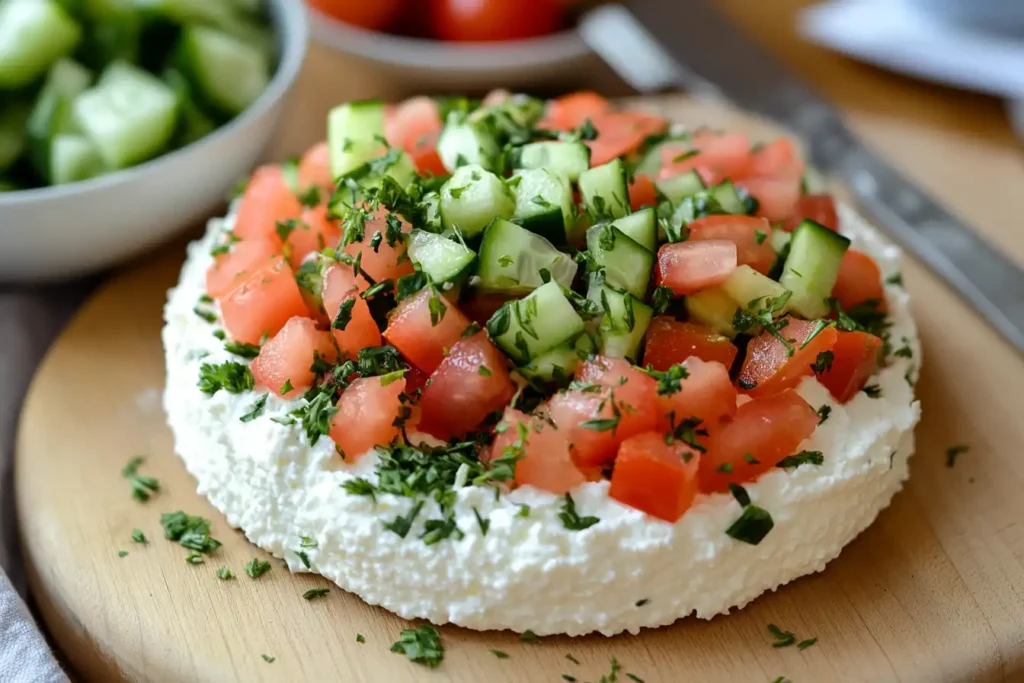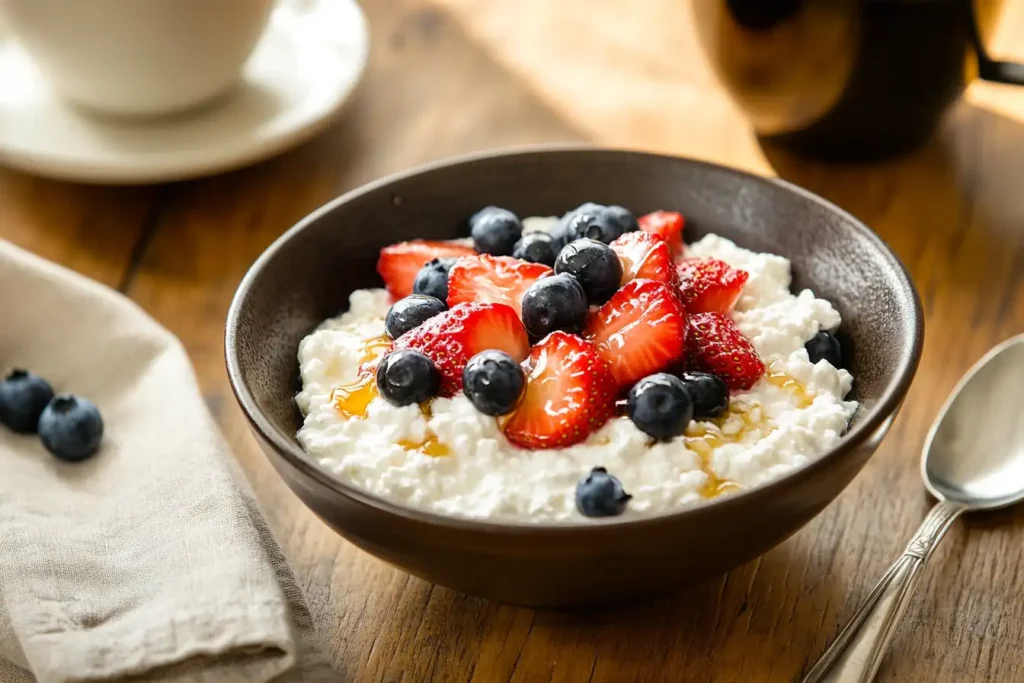Cottage cheese has long been a versatile staple in kitchens worldwide, celebrated for its creamy texture, subtle tang, and adaptability. Moreover, from health-conscious eaters to culinary adventurers, it finds its place in sweet and savory dishes alike. In this article, we’ll uncover what is the most popular way to eat cottage cheese, explore its use in meals and snacks, and share why it’s a nutritional powerhouse. Whether you’re a seasoned cottage cheese lover or new to this humble food, you’re sure to discover fresh and exciting ways to enjoy it.
Introduction to Cottage Cheese and Its Versatility
What Is Cottage Cheese?
Cottage cheese is a fresh cheese curd product known for its mild flavor and creamy consistency. Additionally, it is made by curdling milk and draining the whey, resulting in a soft, chunky texture that makes it stand out among other cheeses. Whether enjoyed plain or dressed up, its simplicity allows it to pair with a myriad of flavors.
Why Is Cottage Cheese Popular?
The appeal of cottage cheese lies in its versatility and health benefits. Moreover, it’s a favorite among dieters, athletes, and foodies alike. For instance, you can eat it straight out of the container, mix it with fruit for a quick snack, or whip it into a creamy base for smoothies. Its popularity stems from the fact that it’s both a delicious and nutrient-dense food that fits effortlessly into diverse dietary preferences.
Nutritional Benefits of Cottage Cheese
Cottage cheese packs a punch when it comes to nutrients. High in protein and low in fat, it’s a go-to choice for those looking to fuel their day. It’s also rich in calcium, B vitamins, and essential amino acids, making it a wholesome addition to any meal. Plus, it’s a versatile substitute in recipes calling for other dairy products like ricotta or cream cheese.
Nutritional Information: Cottage Cheese (Per 100g)
Cottage cheese is not only versatile and delicious but also packs a powerful nutritional punch. Here’s a breakdown of its typical nutrient content per 100 grams:
| Nutrient | Amount | Daily Value (%DV) |
|---|---|---|
| Calories | 98 kcal | 5% |
| Protein | 11.1 g | 22% |
| Total Fat | 4.3 g | 7% |
| Saturated Fat | 1.8 g | 9% |
| Cholesterol | 17 mg | 6% |
| Sodium | 364 mg | 15% |
| Total Carbohydrates | 3.4 g | 1% |
| Dietary Fiber | 0 g | 0% |
| Sugars | 2.7 g | — |
| Calcium | 83 mg | 8% |
| Iron | 0.1 mg | 1% |
| Potassium | 104 mg | 3% |
Key Nutritional Highlights
- High Protein Content: With over 11 grams of protein per 100g, cottage cheese is ideal for muscle repair, weight management, and enhancing satiety. Furthermore, its high protein content makes it a valuable addition to a balanced diet.
- Low Calorie: At just 98 calories, it’s a light yet filling addition to any meal.
- Rich in Calcium: Promotes bone health and aids in muscle function.
- Moderate Sodium: While beneficial for flavor, individuals on low-sodium diets should monitor intake.
Cottage cheese strikes a balance between being a healthy choice and a versatile ingredient. Moreover, its adaptability makes it a star in various cuisines worldwide. Including it in your diet supports both flavor and function.
Popular Ways to Enjoy Cottage Cheese
Classic Methods: Plain or with Fruit
One of the most popular ways to eat cottage cheese is by keeping it simple. For example, many people enjoy it straight from the container, appreciating its creamy and slightly tangy flavor. In addition, for a touch of sweetness, it’s often paired with fresh fruits like pineapple, berries, or peaches. These combinations, therefore, create a refreshing, nutrient-packed snack or breakfast option. Adding a drizzle of honey or a sprinkle of cinnamon elevates the taste further while keeping the health benefits intact.
If you’re curious about creative breakfast pairings, you might also explore cottage cheese recipes that incorporate pancakes and other morning favorites.
Savory Toppings: Vegetables and Spices

For those who prefer savory flavors, cottage cheese makes an excellent base for various toppings. For instance, try adding chopped cucumbers, tomatoes, or olives for a Mediterranean twist. Additionally, a dash of black pepper, paprika, or everything bagel seasoning can transform plain cottage cheese into a savory delight. On the other hand, some even use it as a healthier substitute for mayonnaise or sour cream in dips and spreads.
Creative Twists: Smoothies and Desserts
Did you know you can blend cottage cheese into smoothies? Additionally, it adds a creamy texture and a protein boost without overpowering the flavor, making it a perfect ingredient for nutritious drinks. What is the most popular way to eat cottage cheese? Cottage cheese can also be used in desserts like cheesecake or fruit parfaits, offering a lighter alternative to traditional ingredients like cream cheese. Its versatility ensures there’s always a new way to enjoy it.
Cottage Cheese as a Meal Ingredient
In Breakfast Dishes: Pancakes and Omelets

Cottage cheese isn’t just a topping; it’s a fantastic ingredient for hearty breakfast dishes. For example, you can add it to pancake batter for extra fluffiness and a boost of protein, or fold it into an omelet for a creamy texture. Furthermore, these options are perfect for starting your day with a delicious and satisfying meal.
In Lunch and Dinner Recipes: Lasagna and Pasta
Cottage cheese shines in lunch and dinner recipes too. It’s a staple in healthier lasagna recipes, replacing ricotta to cut calories while maintaining creaminess. You can also mix it into pasta dishes to create rich, flavorful sauces. Pairing cottage cheese with spinach or herbs like basil enhances its taste, making it a go-to ingredient for balanced meals.
Cottage Cheese in Snacks and Spreads
Need a quick snack? Simply mix cottage cheese with herbs and spices to create a protein-rich spread for crackers or veggie sticks. Alternatively, for a bolder option, you could try pairing it with smoked salmon or roasted red peppers, which add both flavor and a touch of sophistication. Moreover, these snacks are easy to prepare and packed with nutrients, proving that cottage cheese is as versatile as it is delicious.
How Regional Preferences Influence Consumption
Cultural Variations in Cottage Cheese Consumption
Across the globe, cottage cheese takes on different roles in culinary traditions. For example, in Eastern Europe, it’s a staple in savory dishes like pierogi or blintzes, offering a creamy filling that pairs well with herbs and spices. Additionally, its versatility makes it adaptable to various regional flavors and recipes. Meanwhile, in India, cottage cheese, known as “paneer,” is often used in curries, though slightly firmer in texture. These regional preferences highlight the versatility of cottage cheese as a foundation for both sweet and savory meals.
In the U.S., cottage cheese is widely enjoyed as a standalone snack or as part of a low-fat, high-protein diet. Furthermore, its adaptability to various cuisines and eating styles makes it a beloved choice across cultures.
Unique Regional Recipes Featuring Cottage Cheese
Local recipes showcase how cottage cheese adapts to cultural flavors. Scandinavian countries often mix cottage cheese with rye bread for a hearty meal, while in Mexico, it’s used to complement spicy salsas in lighter fare. These unique twists provide inspiration for exploring what is the most popular way to eat cottage cheese in different styles. Moreover, they showcase how versatile and adaptable this ingredient can be across various cuisines.
Benefits of Incorporating Cottage Cheese Into Your Diet
Cottage Cheese for Weight Loss
Cottage cheese is a dieter’s dream. In addition, with its low calorie count and high protein content, it keeps you full without weighing you down. Moreover, its high satiety factor makes it a smart snack choice for those looking to manage their weight effectively. Therefore, pairing it with vegetables or whole-grain crackers creates a balanced, healthy option.
Protein-Packed Energy Source
For athletes and fitness enthusiasts, cottage cheese is a protein powerhouse. It’s packed with casein, a slow-digesting protein that supports muscle repair and growth. This makes it an ideal snack post-workout or before bed, providing sustained energy and recovery benefits.
Suitability for Specific Diets
Whether you’re following a low-carb, gluten-free, or vegetarian diet, cottage cheese fits seamlessly into your meal plan. Its adaptability ensures it can meet diverse nutritional needs while offering an enjoyable eating experience.
What to Avoid When Eating Cottage Cheese
Common Additives to Be Wary Of
While cottage cheese is often praised for its health benefits, not all varieties are created equal. Many store-bought brands contain added sugars, preservatives, or artificial flavorings that can diminish its nutritional value. Therefore, always check the ingredient list and opt for versions with minimal additives. Additionally, low-fat or fat-free options sometimes include thickeners or stabilizers, which may not align with a clean-eating approach.
When Cottage Cheese Goes Bad: Signs to Look For
Cottage cheese is perishable, and eating it past its prime can lead to unpleasant experiences. Therefore, it’s important to look out for changes in texture, color, or smell—clear signs that it’s no longer safe to eat. Additionally, if you notice excessive water separation, mold, or a sour odor, it’s best to discard it to avoid any potential health risks. Proper storage, such as keeping it in a tightly sealed container in the fridge, can help extend its shelf life.
Being mindful of these factors ensures that you can safely enjoy what is the most popular way to eat cottage cheese, without compromising your health or the quality of your meals.
FAQs About Eating Cottage Cheese
How Do People Normally Eat Cottage Cheese?
Cottage cheese is commonly enjoyed in simple yet satisfying ways. For instance, many people eat it plain or mix it with fruits like strawberries, blueberries, or pineapple for a naturally sweet, nutritious snack. On the other hand, for a savory option, it’s often paired with vegetables, crackers, or used as a topping for baked potatoes, offering a versatile and delicious choice for any palate. Another popular approach is blending it into smoothies, which gives them a creamy texture and a significant protein boost. Its versatility ensures it can be incorporated into almost any meal.
What Do Most People Put on Cottage Cheese?
Toppings depend on whether you prefer sweet or savory flavors. For a sweet treat, fresh or dried fruits, honey, and granola are common favorites. Savory enthusiasts often add chopped herbs, a sprinkle of black pepper, or vegetables like cucumbers and tomatoes. Many even use cottage cheese as a dip for carrots, celery, or pita chips. The most popular toppings not only enhance the taste but also add variety to your diet.
What to Avoid in Cottage Cheese?
While cottage cheese is generally healthy, there are a few things to be cautious about. Some brands add sugars, artificial flavorings, or high levels of sodium, which can negate its health benefits. Always check the label and choose products with fewer additives. Additionally, avoid eating cottage cheese past its expiration date. Spoiled cottage cheese can develop a sour smell, discoloration, or watery separation, which are clear signs it should be discarded.
Why Is Cottage Cheese So Addictive?
The combination of its creamy texture, high protein content, and mild flavor makes cottage cheese incredibly satisfying. Protein is known to reduce hunger and keep you feeling full, which contributes to its crave-worthy nature. Moreover, its adaptability to both sweet and savory dishes makes it a versatile choice that many people enjoy daily. Its addictive quality isn’t a bad thing when paired with healthy additions like fruits or vegetables.
Can Cottage Cheese Fit into Any Diet?
Yes, cottage cheese fits into a variety of diets, including low-carb, high-protein, and vegetarian plans. It’s also gluten-free, making it suitable for those with gluten sensitivities. Even people on keto diets enjoy it because of its low carbohydrate content. With its flexibility, it can easily align with most dietary goals.
Conclusion: Why Cottage Cheese Remains a Favorite
Summary of Popularity and Benefits
Cottage cheese continues to be a beloved choice for its incredible versatility, nutritional value, and ability to adapt to any taste preference. Whether you enjoy it as a quick snack with fruits, as part of a savory meal, or as a protein-packed dessert, it seamlessly fits into a variety of diets and lifestyles. Its rich nutrient profile, including high protein and low calories, makes it an appealing option for health-conscious individuals.
When exploring what is the most popular way to eat cottage cheese, it’s clear that no single method stands out above the rest. Instead, its universal appeal lies in the fact that it can be tailored to individual tastes and cultural preferences.
Encouragement to Explore Cottage Cheese Recipes
With endless possibilities, cottage cheese invites creativity in the kitchen. Try it in recipes you haven’t explored before, like lasagna, smoothies, or savory spreads. If you’re unsure where to begin, start with a simple pairing of cottage cheese and your favorite fruit or seasoning. The opportunities are endless, and the results are always satisfying.
Curious to discover more mouthwatering recipes? Check out What is the Difference Between American Cheesecake and Italian Cheesecake? for inspiration and a taste of cheesecake in different cultures.


1 thought on “What Is the Most Popular Way to Eat Cottage Cheese? Creative & Delicious Ideas”